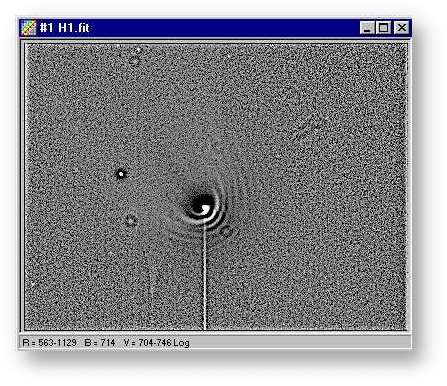|
LAB #1 |
How to enhance dust halos in high resolution CCD Images of Comet C/1995 O1 (Hale-Bopp)
|
M. Nicolini |
We present a CCD image of comet C/1995 O1 (Hale-Bopp) taken on 1997 April 9, using the 0.4m f/5.5 of the Observatory of Cavezzo (MPC 107) This image, taken when C/1999 O1 was near perihelion, reveal the existance of five halos in the in the comet's coma. We will see how to enhance the apparence of these halos. For the next image processing steps, download and unzip the image H1.FIT
Image Processing Steps
- Run Astroart and load the image H1.FIT with File | Open FITS.
- Duplicate the image with Image | Duplicate. A new image NONAME00.FIT will be created.
- Now we will create a sort of unsharp mask: select NONAME00.FIT and in the menu Filter select Low pass | Gauss: input 2.0 in the Sigma? dialog window: this will softly blur the image NONAME00.FIT.

Fig. 1 - Creating a gaussian mask
- Select the original image H1.FIT then, selecting Arithmetic | Merge, will appear the Merge dialog window; choose Divide from the operators combo box as shown in the figure below.

Fig. 2 - The Powerful Merge Window
- Now look at the H1.FIT image: the comet seems disappeared! Don't worry: you must adjust the threshold levels to see the results of the image processing. There is a fast way to do this: just click with the mouse on the status bar of the image and you will be surprised of the results (see figure below): note the impressive sharpness of the dust halos around the false nucleus of the comet: it looks like some ancient drawings of the coma of the comet Donati 1858.
If we should know the rotational period of the nucleus of the comet, with this sharp image of the dust halos we can calculate the velocity of ejecta from the comet ... but this will be the subject of the next item of ASTROART in LAB.

Fig. 3 - Dust halos inside the Hale-Bopp coma.
- Save the results as a FITS file.
|
NOTE |
The processing has enhanced two typical defects of CCD imaging. At first, the stright vertical line starting from the false nucleus of the comet: it is a smearing effect due to the absence of a fast shutter in the CCD camera (not to be confused with the blooming effect). At second the processing has enhanced the presence of dust particles on the glass window of the CCD camera (two are more visible than others as small dark rings around the coma shells, a third with a bright core inside, is actually a star). Dust particles are visible because we did not do any flat field correction on the image.
|
© 1998-2000
MSB software - All rights reserved
|


